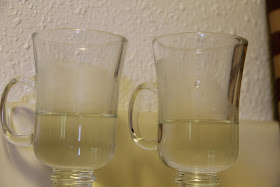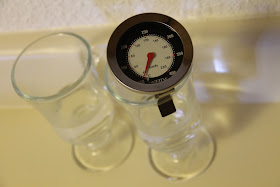On Thursday, we
wrote about the second law of thermodynamics, which explains, in a sense, why clutter seems to naturally increase around a homestead of any kind. Today, we'd like to write about the fourth law of thermodynamics, which is much less-known. The fourth law states that when the ambient temperature approaches summertime values, residential buildings will experience a dynamic flow of wasps attempting to construct nests in the protected outdoor spaces most inconvenient for the occupants of said buildings. (Don't bother looking that up; it's only in very advanced textbooks not available to the general public.) We have experienced the fourth law in full force this summer. (To the tune of two dozen nests around our garage and shed, although not all of them are active.) And like the second law, we will fight thermodynamics on this front as well.
 |
| Accentuated constriction between thorax and abdomen, long gangly legs, loitering around in sheds...yup, that's a wasp alright. |
It is actually with mixed feelings that we write this post. Wasps are
quite beneficial for the garden, preying especially upon pesky caterpillars of various flavors and many other antagonistic insects. We would prefer to ignore the wasps if possible, but when they are building in our primary work areas and other places we are likely to disturb them (as dictated by thermodynamics), they've gotta go. Also, the European paper wasps we're seeing are non-native and have
displaced many of the local native species, basically by being better at their job than the natives were. Apparently, it's possible to relocate the nests by taking them down and
reattaching them elsewhere with superglue, but when the colony has more than one or two wasps, we can't see this ending happily for anyone nearby.
The standard approach to removing these helpful pests is to go to the store, get a can of
synthetic chemical-laced spray, and blast the nest at dusk from 15-20 feet away. (Other/inert ingredients = petroleum distillates, which are
not all that 'inert' for humans or aquatic life). The wasps fall to the ground, hacking and sputtering, and die a minute later. The nest is knocked down and stomped a couple times with thick-soled shoes just to make sure everything is good and dead. (Ironically, just the "inert" ingredients are typically enough to kill
the wasps, which you can see for yourself if you happen to have
petroleum distillates around, e.g., for cleaning up oil-based paint.) The "active" ingredients are typically pyrethroids, which are
longer-lasting synthetic versions of natural pyrethrins. The natural pyrethrins can be extracted from
chrysanthemum flowers and are even permitted in "official"
organic gardening. Pyrethroids are not.
We started thinking about what we might do to get rid of the wasps instead of buying a can of spray. So, we began our reseach on natural ways to kill wasps by doing what many technically literate humans do these days: we asked the Great Googley Moogley. As usual, the internet was full of people who have already solved our problem. Apparently a
soap and water mixture will knock 'em down pretty well, and all we needed was a sprayer to get the mixture there from a safe distance. The sprayers are not terribly expensive, and have a multitude of other uses around the homestead. (Supersoakers have such small reservoirs and slow delivery that they're not even practical.)
So, here's how it went down in our neck of the woods.
 |
| Trouble brewing. |
 |
| So just in case any wasps are reading this post, here's a message just for them. Yes, that is the wasp's head from the previous picture, cropped to perfection in MS Paint. |
 |
| Here's our sprayer, it's a one-gallon model. $10 at Home Depot. We used a mixture of about 0.5 cup dish soap in 0.5 gallon water, but we didn't need nearly that much solution, even for the two-dozen nests we had to knock down. |
 |
| We pumped it up fifteen or sixteen times and adjusted the sprayer nozzle to put out a good jet. That looks like it shoots pretty far! At least we'll have a chance to get away if it doesn't work. |
 |
| Here it goes! We sprayed the heck out of the nest, but in reality, all the wasps fell to the ground in the first few seconds, hacking and sputtering just like they do when sprayed with the commercial spray. Sorry there's no close-up of the action--the photographer was being kind of a scaredy-cat. :-) |
 |
| And then after a minute, they just kind of...died. Weird. But there you have it...soapy water is just as effective as a can of commercial wasp spray. Apparently it works for two reasons: insects breathe by diffusion of oxygen through tiny holes in their skin called spiracles and are covered in a waxy coating. Just water, with a high polarity and surface tension, doesn't affect insects because it's repelled from the waxy coating, and the insect can close its spiracles to keep the water from getting in. The soapy water has a much lower surface tension, so it can get into the spiracles (maybe through capillary action?), which essentially stops the insect from 'breathing'. Also, the soap can dissolve the waxy coating, which lets both the soap and water underneath the insect's exoskeleton, where they wreak havoc on cell membranes and stuff. Not sure if anyone has actually quantified those two effects, but just spraying insects with water doesn't kill them, so the soap is definitely doing something. Now we just have to figure out what to do with the extra soapy water we mixed up. Car wash? Cat wash? Extra distance from the sprayer would be good there. Here's an idea: Katie, you take this little pistol-shaped squirt gun. I'll use this big, lumbering, slow sprayer thing. Now, we'll stand back to back, take ten paces... |
Have you taken out any yellow-and-black pests without the cans of commercial spray? Do you have a good way to encourage wasps to relocate without having to kill them? Let us know in the comments section below!





















































